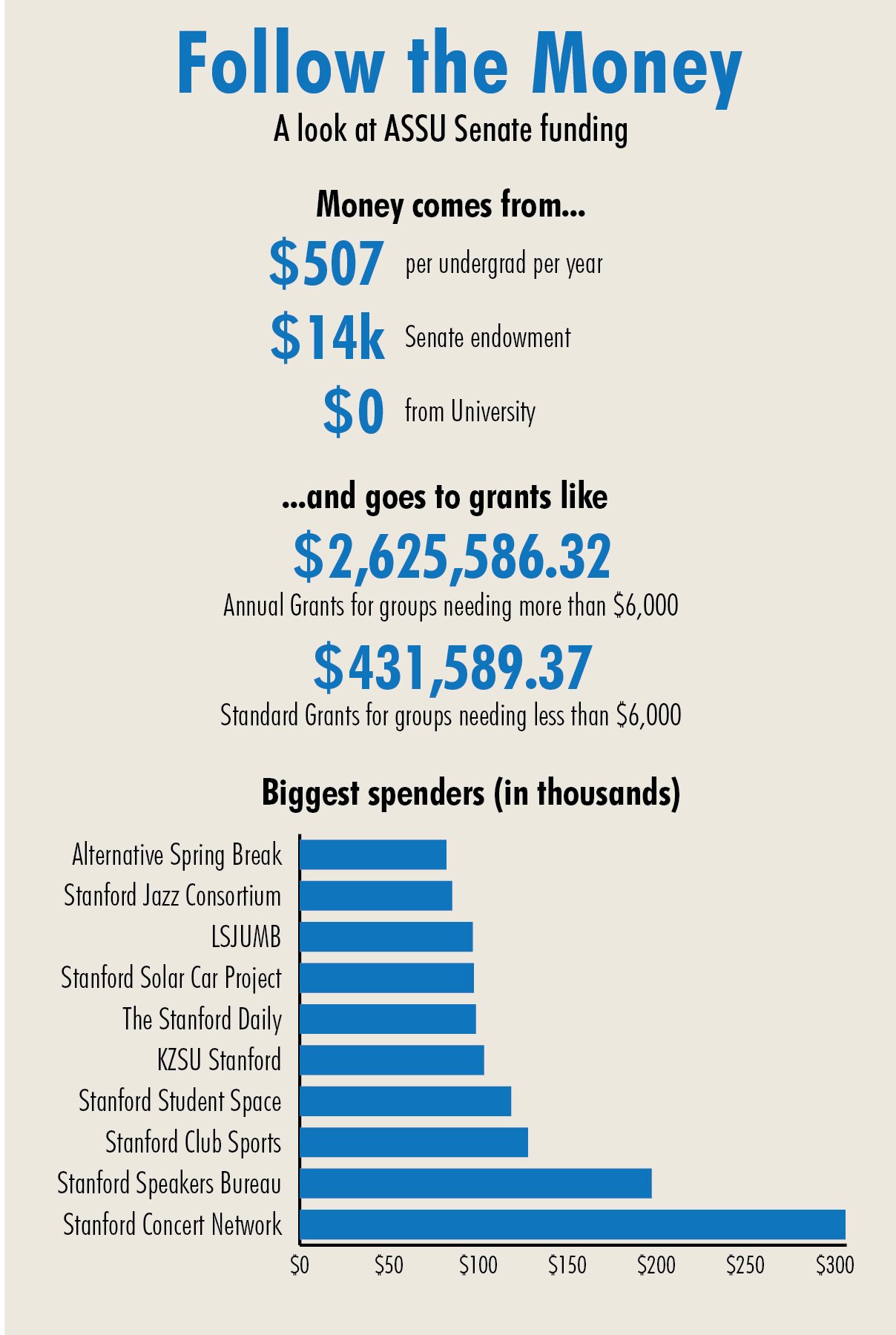The 18th Undergraduate Senate will handle a sum of over $3 million in the 2016-2017 academic year. Though most students know that the bulk of Senate funds go to student groups, fewer are familiar with the funding machinery behind the programming — and the challenges that come with stretching the dollar across the over 700 registered student organizations on campus.
The Daily interviewed several Senate members in order to explain the trials and triumphs of funding student activities for a 7,000-strong undergraduate population.

Funding woes
A perennial problem for the Senate is running out of funds to meet ad-hoc requests from groups by quarter’s end. Although the sum of money they disburse is substantial, demand still outstrips supply.
The Standard Grants that the Senate votes to disburse during regular meetings are just one category of funding on which the wide variety of student groups at Stanford draw. In the 2016-2017 school year, the $507-per-student yearly activities fee paid by undergraduates created a pool of over $3 million, of which $2.6 million went to Annual Grants (formerly called Special Fees) for groups needing more than $8,000. The remainder went mostly to the smaller-scale Standard Grants. The Senate votes directly on individual Standard Grant requests, while the Annual Grants are decided by the whole student body during the spring election season.
ASSU Assistant Financial Manager Luka Fatuesi ’17 explained that the over $430,000 that goes to Standard Grants for student groups leaves each group with just $620 on average a year.
“I can guarantee within the past five years the Senate has overextended itself,” Fatuesi said.
When funds ran low this quarter, the Senate was forced to turn away groups that sought funding for activities that were not “necessary for the group,” such as meeting food funds, according to Senate Chair Shanta Katipamula ’19.
For instance, Stanford Pre-Education Society President Otto Zhen ’18 appealed the Senate’s denial of his $50 food funding request at a meeting in October, only to find that other groups — such as the Stanford Pre-Medical Society and Stanford Women in Politics — were having their requests cut substantially at the same time.
Katipamula described the denials as regrettable but necessary for robust student funding for the rest of the year.
“We’re not here to hoard money,” Katipamula said. “We’re here to disburse money to student groups. We’re just making sure that we’re being very mindful of what events the money is allocated to.”
Struggles with day-to-day funding
Student groups’ expenses are as diverse in amount as in nature, with the quantity disbursed ranging from the $300,000 given to the Stanford Concert Network alone to the $21.90 requested by the Student and Labor Alliance in the fall. Last year, every single Annual Grant request was approved by the student body, tightening the constraints on day-to-day Standard Grant funding.
While some have suggested that the high turnover rate for undergraduate senators has worsened the budgeting problem by whittling away at institutional knowledge, the current Senate has sought to alleviate the problem by initiating quarterly budget caps that ration available funds throughout the year.
Though the Senate exceeded its cap in fall quarter, Appropriations Committee Chair Cenobio Hernandez ’18 remains optimistic that the Senate will meet the winter and spring funding caps more easily.
“[The problem was] likely due to false predictions and bad analysis of data from previous years,” Hernandez said. “Student groups take their funding for granted, whereas it really can be a problem, and they should ask further in advance so it can be appropriately allocated.”
“A big issue for the Appropriations Committee has been that people come in for requests … with the assumption that they are guaranteed funding, but I think it is very important to take away this assumption,” Hernandez added.
Stretching the dollar
While the grind of approving and rejecting funding requests takes up a sizable portion of the Senate’s time, the Senate has also been able to launch its own initiatives for student life through other sources of funding.
Senator Jasmin Espinosa ’18 successfully organized a spring break meal fund for low-income students staying on campus in March 2016, of which $4,500 came directly from the Senate. The Senate also recently funded a Full House bill to subsidize club fees for low-income students and joined forces with the Graduate Student Council to save club sports after they failed to secure enough votes to receive Annual Grant funding.
All of these funds have come from Senate reserves or the Senate discretionary fund. The $14,000 discretionary fund encompasses the Senate’s operational expenses, food and initiatives, such as the spring break meal fund.
Despite the day-to-day struggles of managing the equivalent of a small nonprofit as undergraduate students, senators also have the opportunity to make the money work for them. Senator Gabe Rosen ’19, who sits on the Appropriations Committee, saw the Senate’s decisions on expensive — but in his view worthwhile — side projects, such as the Full House bill as an expression of their principles.
“At the end of the day, we as senators want to make sure that nobody has to make the choice between helping to support their family or being able to join an organization with dues,” Rosen said in a discussion on the Full House bill.
Correction: An earlier version of the article mistakenly stated that the University had discontinued club sports funding. The Department of Athletics, Physical Education and Recreation and Student Activities and Leadership continue to provide support for club sports.
Contact Jordan Payne at jpayne1 ‘at’ stanford.edu and Jack Gartland at gartland ‘at’ stanford.edu.
